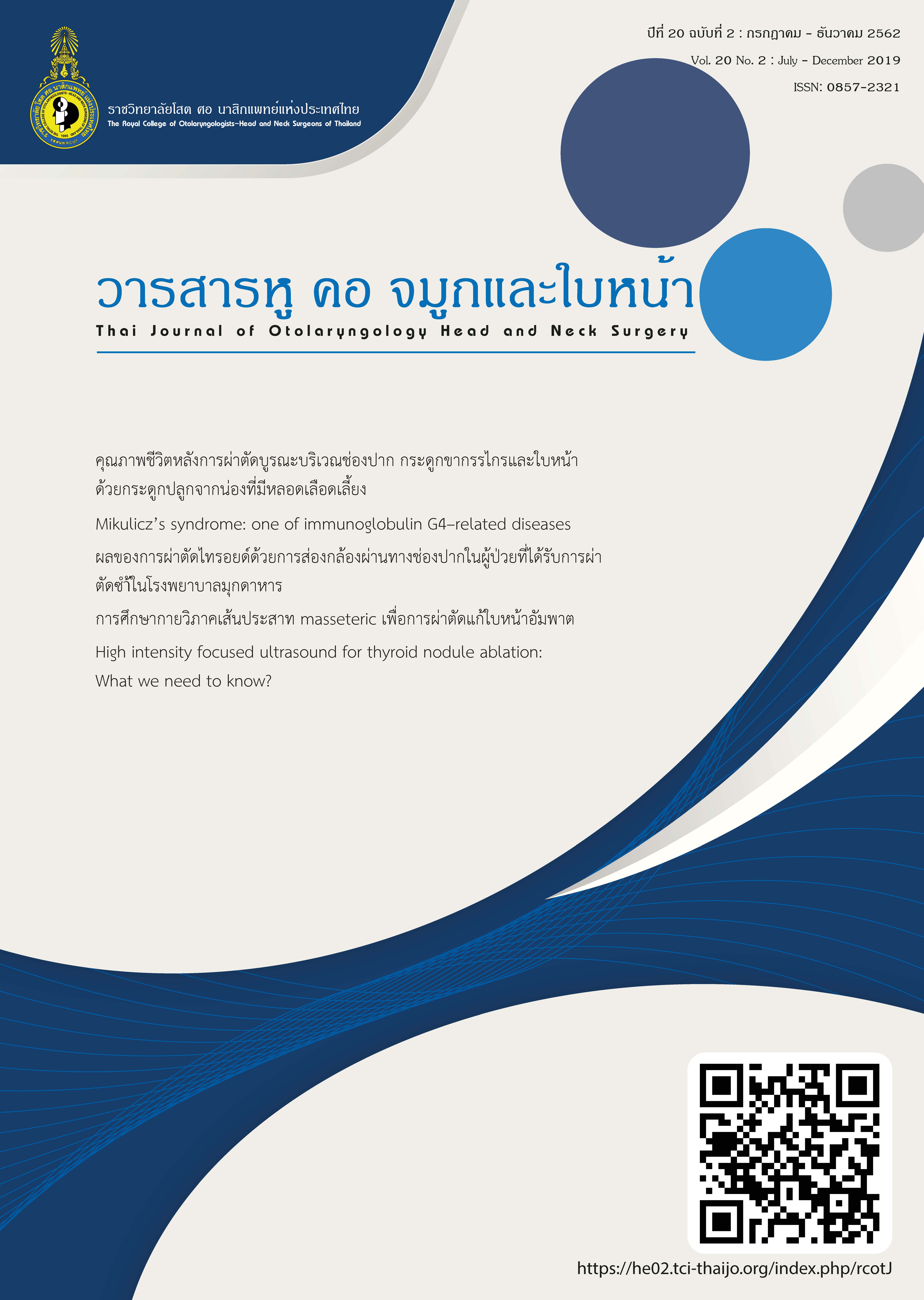High intensity focused ultrasound for thyroid nodule ablation: What we need to know?
Main Article Content
Abstract
For the management of the large in size benign thyroid nodules or causing local pressure symptoms, surgical resection is the best option.Although there are many possible complications of surgery or the general anesthesia could
happen to the patients even in the experienced hands. Minimal or noninvasive procedures for treatment of solid tumors have been investigated continuously, in order to make the alternative treatment planning decisions. There is an interest
in developing noninvasive treatment for thyroid nodules such as laser ablation, microwave ablation and radiofrequency ablation. Recently, High-intensity focused ultrasound (HIFU) has been suggested for thyroid nodules treatment
and reported some promising results. In addition to thyroid nodules, allergic rhinitis and several HIFU applications in the Head and Neck area are suggested.
Applications of ultrasound in medicine for the rapeutic purposes have been used for many years. HIFU is a noninvasive therapy and maybe an alternative to the surgical resections.Currently HIFU has the US-Federal and Drug
Administration approved for the treatment of uterine fibroids, essential tremor, painful bone metastases, prostate cancer and benign prostatic hyperplasia. Other indications such as liver,thyroid, pancreas, renal, brain, benign and
malignant tumor treatment and various medical conditions are being researched.
Reduction of tumor mass after HIFU treatment resulted from ultrasound energy absorbing in tissue during wave transmission induce a focused coagulative thermal necrosis along with nonthermal mechanisms. Target is damaged with minimal effect to surrounding tissues.
The purpose of this review is to provide a foundation of High-intensity focused ultrasound knowledge and applications.
Article Details
ต้นฉบับที่ส่งมาพิจารณายังวารสารหู คอ จมูก และใบหน้า จะต้องไม่อยู่ในการพิจารณาของวารสารอื่น ในขณะเดียวกันต้นฉบับที่จะส่งมาจะผ่านการอ่านโดยผู้ทรงคุณวุฒิ หากมีการวิจารณ์หรือแก้ไขจะส่งกลับไปให้ผู้เขียนตรวจสอบแก้ไขอีกครั้ง ต้นฉบับที่ผ่านการพิจารณาให้ลงตีพิมพ์ถือเป็นสมบัติของวารสารหู คอ จมูกและใบหน้า ไม่อาจนำไปลงตีพิมพ์ที่อื่นโดยไม่ได้รับอนุญาต
ตารางแผนภูมิ รูปภาพ หรือข้อความเกิน 100 คำที่คัดลอกมาจากบทความของผู้อื่น จะต้องมีใบยินยอมจากผู้เขียนหรือผู้ทรงลิขสิทธิ์นั้นๆ และใหร้ะบุกำกับไว้ในเนื้อเรื่องด้วย
References
2. Kovatcheva RD, Zaletel K. High-intensity focused ultrasound for thyroid nodule ablation:the evidence to date. Reports in Medical Imaging. 2017;10:9-16
3. Esnault O, Franc B, et al. High-intensity focused ultrasound ablation of thyroid nodules:first human feasibility study. Thyroid. 2011 Sep;21(9):965-73.
4. Esnault O, Franc B, et al. High-intensity focused ultrasound for localized thyroid-tissue ablation: preliminary experimental animal study.Thyroid. 2004 Dec;14(12):1072-6.
5. Miller DL, Smith NB, Bailey MR, et al. Overview of therapeutic ultrasound applications and safety considerations. J Ultrasound Med. 2012;31(4):623-634.
6. Tempany CM, McDannold NJ, Hynynen K, Jolesz FA. Focused ultrasound surgery in oncology: overview and principles. Radiology.2011;259(1):39-56.
7. She WH, Cheung TT, Jenkins CR, Irwin MG.Clinical applications of high-intensity focused ultrasound. Hong Kong Med j. 2016 Aug;22(4):382-92.
8. Lang BH, Wu ALH. High intensity focused ultrasound (HIFU) ablation of benign thyroid nodules–a systematic review. J Ther Ultrasound. 2017;5:11.
9. Lang BH, Wu ALH. The efficacy and safety of high-intensity focused ultrasound ablation of benign thyroid nodules. Ultrasonography.2018;37(2):89-97.
10. Kotewall N, Lang BHH. High-intensity focused ultrasound ablation as a treatment for benign thyroid diseases: the present and future.Ultrasonography. 2019;38(2):135-142.
11. Brian HL, Yu-Cho W, Carlos KW. HighIntensity Focused Ultrasound for Treatment of Symptomatic Benign Thyroid Nodules:A Prospective Study Radiology. 2017 284:3,897-906.


